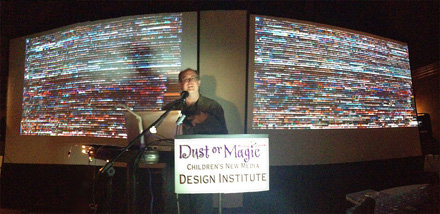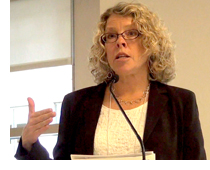Thursday, November 14th, 2013
[The following is an article I wrote for the November 14, 2013 issue of KidScreen’s online iKids Magazine.]
Theo Gray, co-founder of Touch Press, presenting the new Disney Animated app. (Click photo to see larger version.)
Every year in early November, there’s a very special children’s interactive media conference called Dust or Magic that’s held a short drive outside of New York City. The name of the event comes from a 17th century Japanese poet, Matsuo Basho, who wrote, “An idea can turn to dust or magic depending on the talent that rubs against it.”
This is the underlying theme that weaves itself throughout the hundreds of apps that are discussed during the event, and a select few that are presented live. In the ever-expanding world of the children’s interactive media, which products are considered “magic” or “dust?” And why? As an industry of creators, we ask ourselves “What can we learn from the good, as well as the bad?”
Dust or Magic is the brainchild of Warren Buckleitner, who is also the editor of Children’s Technology Review magazine, a former blogger for The New York Times and an expert in the children’s digital world.
This was my 12th year attending Dust or Magic. Over that time I’ve seen the interactive industry grow through talking books from LeapFrog, numerous Tickle Me Elmo dolls, virtual worlds like Club Penguin and Webkins, all the way to today’s vibrant app world for kids. I’ve seen many unknown speakers go on to release top selling products in their field, create new and compelling ways to engage children, and all the while raise the bar of quality for the entire children’s industry. This year there was no shortage of stellar presentations, and three in particular are worth sharing with those who could not attend the event. These three presentations rose the bar.
The opening presentation was delivered by Theo Gray, founder and app developer for the company Touch Press. Gray’s accomplishments include receiving an ig Nobel Prize in chemistry, but his app work is second to none. Gray has created a number of stellar apps, one called The Elements, another the Solar System, which sets new standards for excellence in app creation. However, at this year’s event he presented his latest work, an app for Disney that chronicles its animation history called Disney Animated. This new body of work was completely amazing, and there was one moment in Theo’s presentation, a breathtaking, jaw-dropping moment. Gray had created a single screen, color bar chart that included frames from every single animated movie ever created by Disney. With a touch of the finger, you could call up a single frame of animation from any movie every created by the company. It was a truly amazing moment.
Later, we were treated to a presentation by the founder and CEO of a small startup called Tinybop. Never heard of Tinybop? They launched their first kids’ app in August, and it has blossomed into the industry’s best overnight success story yet. This number-one selling app is called The Human Body and it’s rewriting the rules of child engagement. Simple. Clean. Funny. Engaging. Enlightening. The founder, Raul Gutierrez, shared his business plan with the Dust or Magic community, and you can see why it was a presentation long to be remembered.
The next notable presentation came from Chip Donohue, dean of distance learning and continuing education for the Erikson Institute as well as senior fellow at the Fred Rogers Center. Over the past few years, Donohue has helped define a best practices position paper for using technology in early learning, an excellent road map for using tablets with young children. As he pointed out in his presentation, there’s been a lot happening in the interactive space over just these last few weeks, and he put together a presentation with all the latest recommendations and best practices for engaging children intentionally through new media platforms. A fantastic resource for everyone in the kids’ biz.
These speakers were accompanied by unreleased new work from Toca Boca and its newly acquired sister company Sago Sago, as well as preschool app development tips from Duck Duck Moose. Magic, it was in the air.
Extra links:
Speaker presentation playlist (15 videos)
App demo playlist (23 videos)



